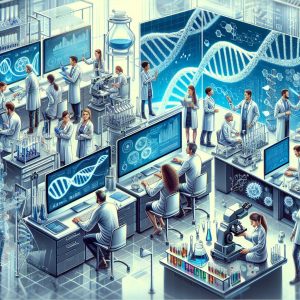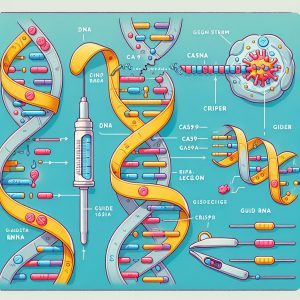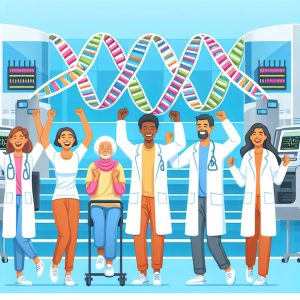Health and Medicine
108 Genetic Therapy of Sickle Cell Disease
Riley Reyes
Genetic Therapy and its effects on society
Connection to sts
Genetic Therapy is a new technology that can manipulate the genetic information of someone’s genetic makeup to alter biological properties. Gene therapy, specifically the therapy for sickle cell disease is an example of the importance of using science and technology coherently, along with their effects on society. Gene therapy is a science studied relatively recently, using newly discovered technologies like CRISPR-Cas9 to potentially cure diseases, making it a prime example for how science, technology, and society affect each other. While gene therapy has the potential to save lives, but can also have some drawbacks, especially due to its relative recency (Abraham, A. A. et al., 2021).
Introduction
Genetics is the “coding” of the body. Each gene contains DNA which is made into proteins through biological processes. Genes can be malfunctional due to a change in the chemical makeup or they can be a mutation, where they are changed during the passing down from parents or faulty reproduction of genes. Gene therapy is being studied to fix a malfunctioning gene or replace a malfunctioning gene with a healthy one. While the possible results of genetic therapy are exciting and extremely beneficial, there are reasons researchers have a difficult time getting therapies approved. Many of the risks that are involved with gene therapy are the processes and techniques used to insert a gene. Most gene therapies use something called a “vector” or a carrier that would be used to transport genes out of and into the body. The most common vector used is a virus (U.S. FDA n.d.). Researchers have found viruses to be very useful in multiple ways, but they can also present risks such as a negative immune system reaction, an infection, and targeting the wrong cells 
There are a few different ways that gene therapy can alter biological properties. The first is replacing a gene that is causing a disease. The disease-causing gene would be removed, and replaced with a gene that would produce healthy proteins to benefit the body. The second way gene therapy could work is by inactivating a disease-causing gene. This can be done by inserting a gene into the same chromosome that would block the production of proteins by the diseased-gene. The last way gene therapy could work is by introducing a new gene into the body. Inserting a new gene into the body can negate, or act oppositely to the disease-causing gene (Mayo Clinic, 2024). Each of these techniques have different qualities that make them better fits for different diseases as gene therapy aims to relieve diseases like cancer, heart disease, and sickle cell disease.
Gene therapy for sickle cell disease
More specifically, there is research about many clinical trials done while trying to approve two genetic therapies for sickle cell disease (SCD). These therapies are called Casgevy and Lyfgenia, and were approved by the FDA at the end of 2023 (Commissioner, O. of the. n.d.) Currently, both gene therapies are only available to patients 12 years or older. Sickle cell disease is a group of blood disorders that is most commonly seen in African Americans. Most sickle cell diseases are caused by a mutation in hemoglobin, a component of the blood that binds to oxygen and is able to deliver oxygen from the lungs to all tissues of the body. The red blood cells become “sickle” shaped which restricts the flow of blood, preventing oxygen from getting to each tissue in the body.
Casgevy was approved for treating SCD in patients 12 years or older that are experiencing vaso-occlusive crises (VOC). During a VOC, tissues of the body are deprived of oxygen resulting in a very painful sensation. The reason that Casgevy is so important is because it is the first gene therapy to be approved using the technology of CRISPR-Cas9.

CRISPR is a protein complex that allows researchers to target a specific sequence, or spot on a gene and make directed cuts on the chromosome, allowing the removal or addition of a gene. In Casgevy’s case, CRISPR is used to make an edit in the gene, enabling the production of fetal hemoglobin which is normally suppressed soon after birth. The fetal hemoglobin is very efficient in moving oxygen around the body as babies need sufficient oxygen, especially when exiting the womb (Adashi, E. Y. et al, 2024).
Lyfgenia, another genetic therapy that targets SCD, uses a viral vector. Using the viral vector, a patients stem cells are removed and modified to produce a derived hemoglobin that functions like our normal hemoglobin, but has a much lower chance of sickling. These modified stem cells are then delivered back to the patient using the viral vector.
Effects of casgevy and lyfgenia
In an article published in, “The American Journal of Medicine”, the implications of bringing the genetic therapies of Casgevy and Lyfgenia were discussed. A main talking point in the article was that these new technologies give rise to the possible cure of what used to be thought of as “incurable” and “life-long” diseases. If genetic therapies like Casgevy and Lyfgenia prove to be effective, more and more children and adults will be given the opportunity to relieve the barriers of SCD and the VOC’s. The article also discusses the trials conducted to measure their effectiveness and safety for patients. As of now, patients must be 12 years or older, and have had two severe VOCs in each of the two years prior to treatment. Along with the safety and effectiveness of these newly approved genetic therapies, there are limitations such as the cost to these technologies. Due to the limited trials and the unavailability of a new technology, it is very expensive to receive either of these genetic therapies (Adashi, E. Y. et al, 2024).
To build on the efforts to approve gene therapies and their safety for patients and society, another article published in, “The National Library of Medicine”, discusses some of the clinical trials being conducted. The article describes that due to the ‘ex vivo’ approach (outside of the body), each removal, and modification are measured within the blood and the genes. There are also “extra” substance harvested as backup for cases in which the body rejects the therapy. Along with the precautions taken, patients are evaluated to make sure their organs are healthy enough to endure the high-dose chemotherapy. All patients are counseled on short and long-term effects.
Another article from the, “National Library of Medicine”, evaluated the effectiveness of two other gene therapies for SCD, lovo-cel and exa-cel. The main data they aimed to gather was the reduction of VOCs and the proportion of participants that remained free of VOCs. The analysis of lovo-cel evaluated a total of 36 patients, of which, “30 achieved the primary outcome of being free of severe VOEs between 6 and 18 months postinfusion.”, and a reduced number of days spent in the hospital, postinfusion, within 24 months. This data is extremely encouraging, showing that patients have had success with genetic therapies.  17 patients were evaluated in the exa-cel trial, of which 16 remained free of severe VOEs for greater than 12 consecutive months. Along with the impressive results, 12 of those patients reported adverse events which are described as, “ascribed to baseline disease”, meaning they are expected effects from the original disease (Nikitin, D. et al,. 2023). Although the data presented in this paper are both encouraging and impressive, there were no studies done on long-term effects and improvements for these gene-therapies, and there are simply not enough patients and reports to confidently confirm the effectiveness and safety of these gene therapies. Patients that were evaluated in this trial were also required to meet certain health requirements, deeming them healthy enough the be treated, which prevents data for patients that are in most need of genetic therapy.
17 patients were evaluated in the exa-cel trial, of which 16 remained free of severe VOEs for greater than 12 consecutive months. Along with the impressive results, 12 of those patients reported adverse events which are described as, “ascribed to baseline disease”, meaning they are expected effects from the original disease (Nikitin, D. et al,. 2023). Although the data presented in this paper are both encouraging and impressive, there were no studies done on long-term effects and improvements for these gene-therapies, and there are simply not enough patients and reports to confidently confirm the effectiveness and safety of these gene therapies. Patients that were evaluated in this trial were also required to meet certain health requirements, deeming them healthy enough the be treated, which prevents data for patients that are in most need of genetic therapy.
Conclusion
In conclusion, the approved gene therapies for SCD have high expectations and provide hope for further studies. The use of scientific research along with the technologies used to analyze the safety and efficacy of genetic therapies creates opportunities for patients to be relieved of barriers due to a disease. Genetic Therapies are a prime reflection for the ways that science, technology, and society equally impact each other as each part plays a role into the research and improvements being made as a result of patient experience and health improvements.
Study Questions
- Which of the following is not a way that gene therapy can alter biological properties?
- Replacing a disease-causing gene
- Inactivating a disease-causing gene
- Inserting a healthy gene
- Removing a disease-causing gene
2. True or false: The clinical trials done of lovo-cel and exa-cel can confidently confirm the effectiveness and safety of genetic therapies.
-
- True
- False
3. What are the two main effects of Casgevy and Lyfgenia on society?
-
- Possible life-long cure and widely available
- Widely available and cost effective
- Limited availability due to cost and a possible life-long cure
- Possible life-long cure and cost effective
Bibliography
Abraham, A. A., & Tisdale, J. F. (2021). Gene therapy for sickle cell disease: Moving from the bench to the bedside. Blood, 138(11), 932–941. https://doi.org/10.1182/blood.2019003776
Adashi, E. Y., Gruppuso, P. A., & Cohen, I. G. (2024). CRISPR therapy of sickle cell disease: The dawning of the gene editing era. The American Journal of Medicine, 137(5), 390–392. https://doi.org/10.1016/j.amjmed.2023.12.018
Center for Biologics Evaluation and Research. (n.d.). What is gene therapy?. U.S. Food and Drug Administration. https://www.fda.gov/vaccines-blood-biologics/cellular-gene-therapy-products/what-gene-therapy
Commissioner, O. of the. (n.d.). FDA approves first gene therapies to treat patients with sickle cell disease. U.S. Food and Drug Administration. https://www.fda.gov/news-events/press-announcements/fda-approves-first-gene-therapies-treat-patients-sickle-cell-disease
Mayo Foundation for Medical Education and Research. (2024, April 23). Gene therapy. Mayo Clinic. https://www.mayoclinic.org/tests-procedures/gene-therapy/about/pac-20384619
Nikitin, D., Beaudoin, F. L., Thokala, P., McKenna, A., Nhan, E., Rind, D. M., & Pearson, S. D. (2023). Gene therapies for sickle cell disease: Effectiveness and value. Journal of managed care & specialty pharmacy, 29(11), 1253–1259. https://doi.org/10.18553/jmcp.2023.29.11.1253
AI acknowledgement
I used Microsoft Co-Pilot to generate images used in this chapter. Images are meant to clarify topics explained in this chapter and amplify connections drawn throughout the chapter. (2024). Co-Pilot [Large Language Model]. https://copilot.microsoft.com

